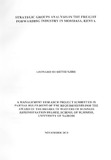| dc.contributor.author | Njiru, Leonard M | |
| dc.date.accessioned | 2016-07-01T14:16:06Z | |
| dc.date.available | 2016-07-01T14:16:06Z | |
| dc.date.issued | 2011 | |
| dc.identifier.uri | http://hdl.handle.net/11295/96723 | |
| dc.description.abstract | Strategic groups represent collections of firms that are similar on key strategic dimensions. Since opportunities are varied across an industry, some industry sectors are hound to have greater profit potential than others and thus linns seek to move from low profit potential segments to higher profit potential segments of the industry. The freight forwarding industry in Mombasa Kenya is wide and complex in size and scope of operations. The study aimed at conducting a strategic group analysis of the freight forwarding industry and further determines the factors that explain the existence of strategic groups in the industry.
This research targeted 70firms for the study using disproportionate stratified random sampling. Firms were selected at random from each strata using disproportional allocation approach. These were then combined to finally get a common sample of 70 firms from the whole industry. Out of this sample, 38firms responded representing a 54.4% response rate. The semi-structured questionnaire was the main instrument of data collection administered to the general managers of the target firms through a ‘drop and pick later' method coupled with telephone calls follow up. A 5-point likert scale was used to assess a number of factors that the research was investigating. Data analysis was conducted using the statistical package for social sciences (SPSS) software and then interpreted in form of tables and graphs.
The freight forwarding industry was found to comprise live strategic groups separated by mobility barriers that are getting stronger with time due to environmental factors that are legal, economic and competitive in nature. The nature of these barriers was found to be ‘resource-based' and reinforced by the legal regulatory framework. The research concludes that managers of freight forwarding companies need to beware of the group to which they belong as well as the environment turbulence that drives change in the industry. The way a firm responds to this dynamism in order to overcome the mobility barriers, determines whether it will stagnate, collapse or move to the desired strategic group in pursuance of growth and achievement of the set business objectives. | en_US |
| dc.language.iso | en | en_US |
| dc.publisher | University of Nairobi | en_US |
| dc.rights | Attribution-NonCommercial-NoDerivs 3.0 United States | * |
| dc.rights.uri | http://creativecommons.org/licenses/by-nc-nd/3.0/us/ | * |
| dc.title | Strategic Groups Analysis In The Freight Forwarding Industry In Mombasa, Kenya | en_US |
| dc.type | Thesis | en_US |



